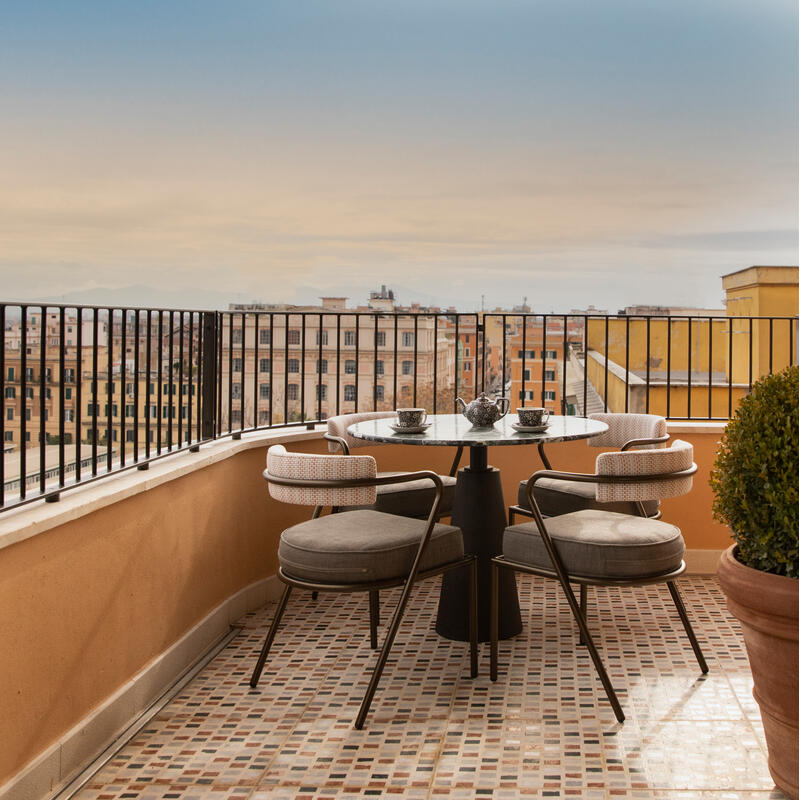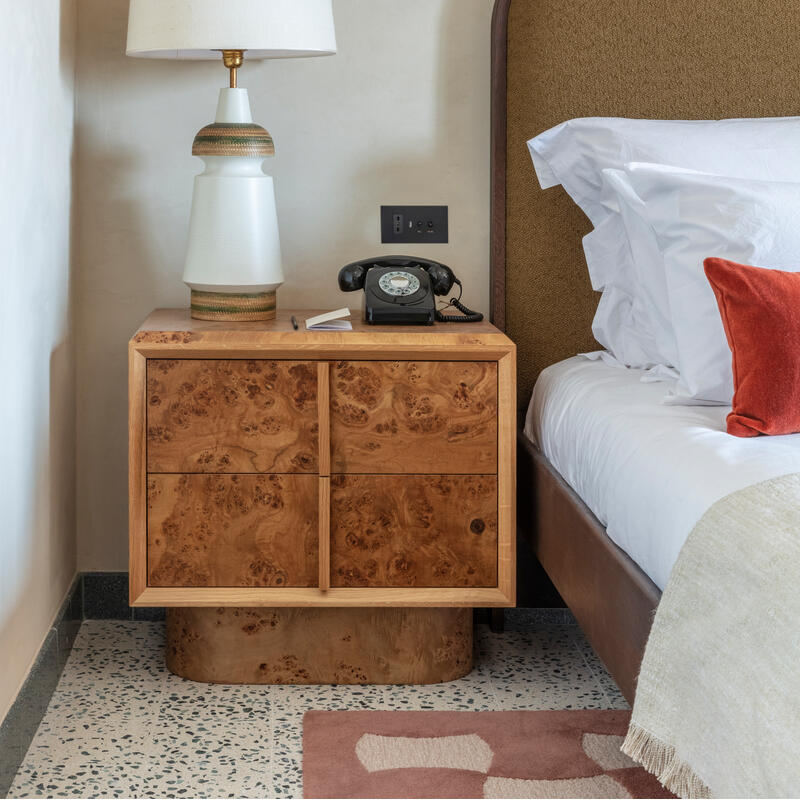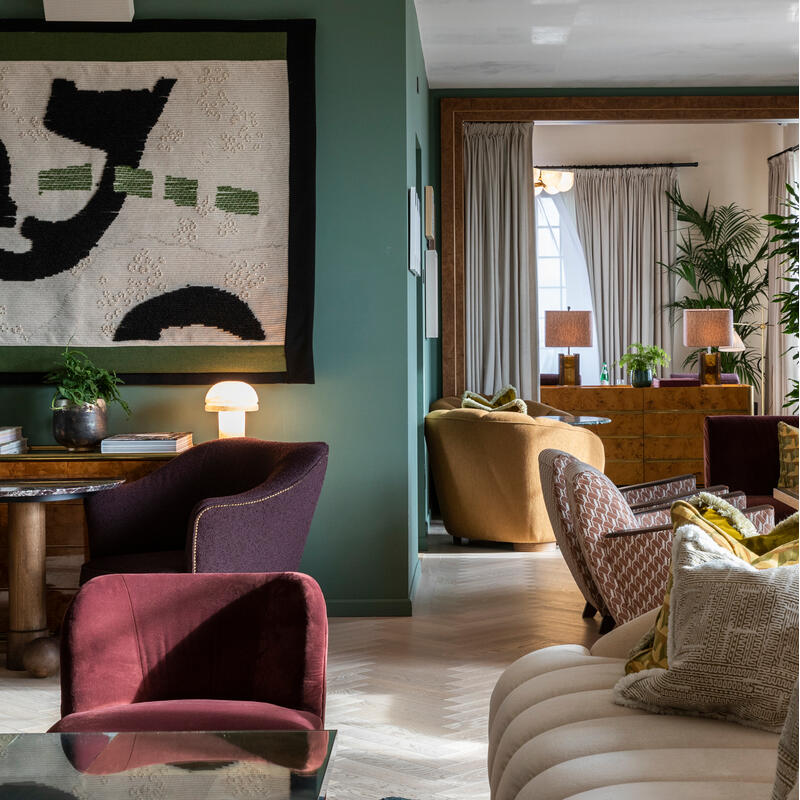By Megan Murray
There are many moments that contribute to pulling off a project as big as Soho House Rome - our newest outpost in Europe, complete with a screening room, Soho Health Club, and rooftop. Like a jigsaw of decisions, each one helps shape the House's identity, becoming anecdotes that explain how the most notable design features came to be.
'There have been a lot of changes,' says Soho House Senior Interior Designer, Alicia Meireles, of the four-year build that spans 10 storeys with 49 bedrooms and 20 apartments. 'The brief evolved, and with it our vision. By the end, our team didn't even need to talk, we knew if something was "Soho House Rome" or not instinctively.'
From the realisation that Italian manufacturers rarely produce wooden flooring (and therefore all plans for timber underfoot needed to change) to Nick Jones happening upon an olive-green car on the street outside and proclaiming this the House's key colour palette, the road to Soho House Rome has featured many twists and turns.
Here, Meireles leads us through the key design decisions behind the creation of Soho House Rome.
Choosing San Lorenzo
'You probably haven't heard of San Lorenzo - this up-and-coming area is a departure from the traditional historic centre that most people picture when they think of this iconic city.
'There's a big student population here, so it feels younger and cooler than the tourist spots, with an arts scene that's slowly growing. Truthfully, it's a little rough around the edges - but we liked that, and because of the location we wanted to embrace that roughness in the design.
'You think of Italian design, and glamour, maximalism and history come to mind. While we nodded to this in some elements, to honour the artistic presence in this neighbourhood we wanted a more graphic feel. This comes through with bespoke patterned textiles featuring wiggly lines and geometric shapes, as well as details like the bold, bright mural on the rooftop.'


Benefits of a new build
'Soho House Rome shows the evolution of Soho House design in many ways, for example, that this is a new-build property. Most Houses have a historic past - look at Paris, which is the former home of French artist and poet Jean Cocteau, or Soho Warehouse in LA, which was a warehouse-turned-art studio and hosted the likes of the Red Hot Chili Peppers.
'But Rome was the perfect place to break the mould, because this city has all the history that members could want already. We wanted to do something different that they couldn't already get here. Speaking to our Founder Rome members, they all say the same thing - San Lorenzo is the only place you could have gotten away with a building of this size and scale with a big rooftop and views of the city.
'Thanks to the enormity of this building it also enabled us to give almost every bedroom its own outdoor space, which in a warm climate is amazing. I love the idea of members waking up and strolling outside onto a balcony.'


Deciding on key materials
'In the Houses we work with upcycled materials to create a lived-in feel. You'll find that reclaimed timber makes up a lot of the flooring throughout our club spaces, and initially this was the plan for Rome.
'After speaking with Nick and the developer who originally commissioned the building, it became clear that this type of flooring is really difficult to source in Italy. We wanted to retain a sense of authenticity, so we started again by looking at the materials that Italy does well.
'The country is fantastic for terrazzo, which is that spotty, broken stone. It has depth of character and colour, and looks stunning as flooring in the bedrooms. There's also a lot of travertine, which we used as flooring in the main club.'
'Print is a big part of Soho House decor, but we found it difficult to find Italian manufacturers that make textiles in our style. So, instead of importing fabrics, we teamed up with a factory in Sardinia to create the hanging tapestries that cover the TVs in the bedrooms. It was a nice way of meeting in the middle.'


Planning the rooftop
'The rooftop was always going to be the jewel in Rome's crown. A challenge I recognised as a designer is that because outdoor fabrics need to be water resistant, they're often limited in colour and pattern.
'For this project, we developed our own outdoor fabrics with patterns designed by local artist, Vincenzo d'Alba. Part of the inspiration for this colourway came from the pool, which we wanted to make a real impact with rich, red tiles. Our pools around the world each have their own identity - Amsterdam is blue, Berlin is green, and now Rome is red.
'Arguably the most important part of the vision for the rooftop, though, came from something Nick said. He wanted members to be able to sit on the Cecconi's terrace and reach up, pluck a lemon from the tree above, and squeeze it onto their pasta. It's quite dreamy of him, but it's also what drives the team. He's got a great eye and is heavily involved in everything.
'That doesn't mean it was easy, though. Several gardeners told us there was no way we could get lemon trees on a rooftop like this, but eventually we found a specialist who helped us make it happen - and it was so worth it.'



Defining details
'We didn't intend to have a set colour palette for the House, but the story of how this developed is a pretty good one. When Nick was visiting during the build, he walked outside onto the street in San Lorenzo and spotted a beautiful car in a specific olive-green colour. He liked the shade so much that he announced it would be the defining colour of Soho House Rome, and we changed all of our fabrics just to match that car.
'Around the House you'll mainly find shades across the spectrum of green, red and some yellows, which became the key colour palette for the space. The tones tend to be rich and warm, with references to many eras from the 1920s and the Art Deco period to the 1960s and 1970s.'
To stay at Soho House Rome, become a Soho Friends member and gain access to our bedrooms globally, plus a host of other benefits. Learn more here. Current members can book bedrooms here.











